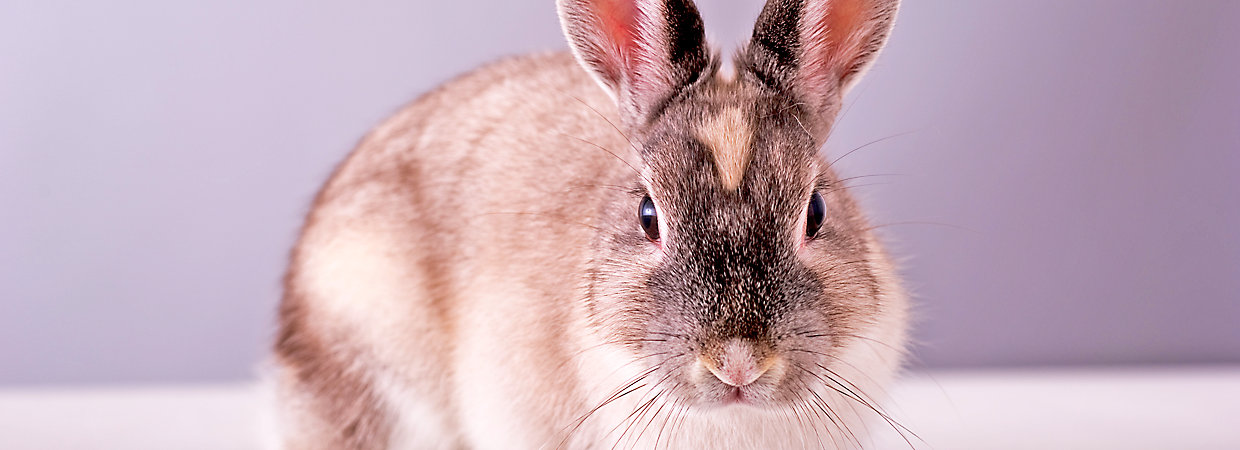Sign up, earn points, get treats
Rabbit Care Guide

In this Article
5 things to know about your rabbit
- Rabbits can weigh from 2 to 10 pounds depending on the breed
- They can live from 6 to 13 years
- Rabbits are most active during the day
- They make excellent indoor pets
- They're playful and gentle
How do I set up my rabbit's home?
Rabbits live together well in pairs, especially if you choose 2 females from the same family. Some rabbits can be litter-box trained.
- A rabbit habitat should be high enough to allow rabbits to stand comfortably on their hind legs, with enough floor space that rabbits can stretch out to their full length. Choose a multilevel habitat that's at least 30 x 29 x 18 inches.
- Place the enclosure near family activities, out of direct sunlight and drafts, in a low-humidity room that's between 65 to 75 degrees Fahrenheit.
- Line the floor with 3 to 4 inches of recycled-paper bedding or wood shavings. (Cedar shavings are not recommended.)
- Place a handful or two of hay at one end of the habitat for nibbling and resting.
- On the other end of the habitat, add a litter box with a half-inch of litter.
What do I feed my rabbit?
Rabbits are herbivores; their diet consists of pelleted food, hay, vegetables, fruit and the occasional treat.
- Rabbit pellets should make up 75% of your adult rabbit's diet. Feed your adult rabbit ¼ cup to ½ cup of pellets daily for every 6 pounds of body weight.
- Dark, leafy greens should make up 20% of your rabbit's diet. Offer 2 cups of greens per 6 pounds of body weight every other day.
- Apple, banana, melon, berry and pineapple should make up 5% of your rabbit's diet. Offer 1 to 2 ounces per 6 pounds of body weight twice a week.
- Provide timothy or oat grass hay for your rabbit at all times.
- Your rabbit should have access to fresh, clean water at all times.
- Rabbits under a year old do well on a diet of grass hay, alfalfa and calcium-rich greens such as kale, romaine lettuce or Swiss chard.
How do I play with and groom my rabbit?
- Rabbits need at least an hour out of their cage every day. Let yours out to walk with a harness or hop around a pen, but don't let the rabbit roam your home unsupervised.
- When interacting with rabbits, lie on the floor to get down to their level.
- Rabbits love to chew. Include some chew toys in their pen, but keep them away from anything around they shouldn't gnaw on, such as electrical cords and houseplants.
- Keep rabbits away from all other pets, especially dogs and cats.
- Rabbits groom themselves, but they also love a gentle brushing.
How do I keep my rabbit healthy?
A rabbit's teeth never stop growing. Gnawing on hay helps keep them healthy. Try not to handle new rabbits for 3 to 4 days to give them a chance to get acclimated to their new surroundings. Once your rabbit is settled in, be sure to contact a veterinarian if you notice any of the following symptoms:
- Cloudy, sunken or swollen eyes
- Overgrown front teeth
- Bare patches in the fur
- Diarrhea or discolored droppings
- Lethargic behavior
- Weight loss; not eating or drinking normally
- Sneezing; discharge from the eyes, nose or mouth
PET SAFETY TIPS
- Use caution when handling pets and remember they may bite or scratch (especially when stressed).
- Never grab the fur or tail.
- ALL ANIMALS can potentially carry viral, bacterial, fungal, and parasitic diseases contagious to humans.
- Thoroughly wash your hands with warm, soapy water before and after contact with any pet or its habitat.
- Adults should assist children with hand washing after contact with a pet, its habitat or aquarium water.
VET ASSURED™
Pets purchased at PetSmart are part of our exclusive Vet Assured™ program, designed by PetSmart veterinarians to help improve the health and well being of our pets.
Our vendors meet a high standard in caring for pets and screening them for common illnesses. This program also includes specific standards for in-store pet care.
PETSMART PROMISE
If your pet becomes ill during the initial 14-day period, or if you're not satisfied for any reason, PetSmart will gladly replace the pet or refund the purchase price.




